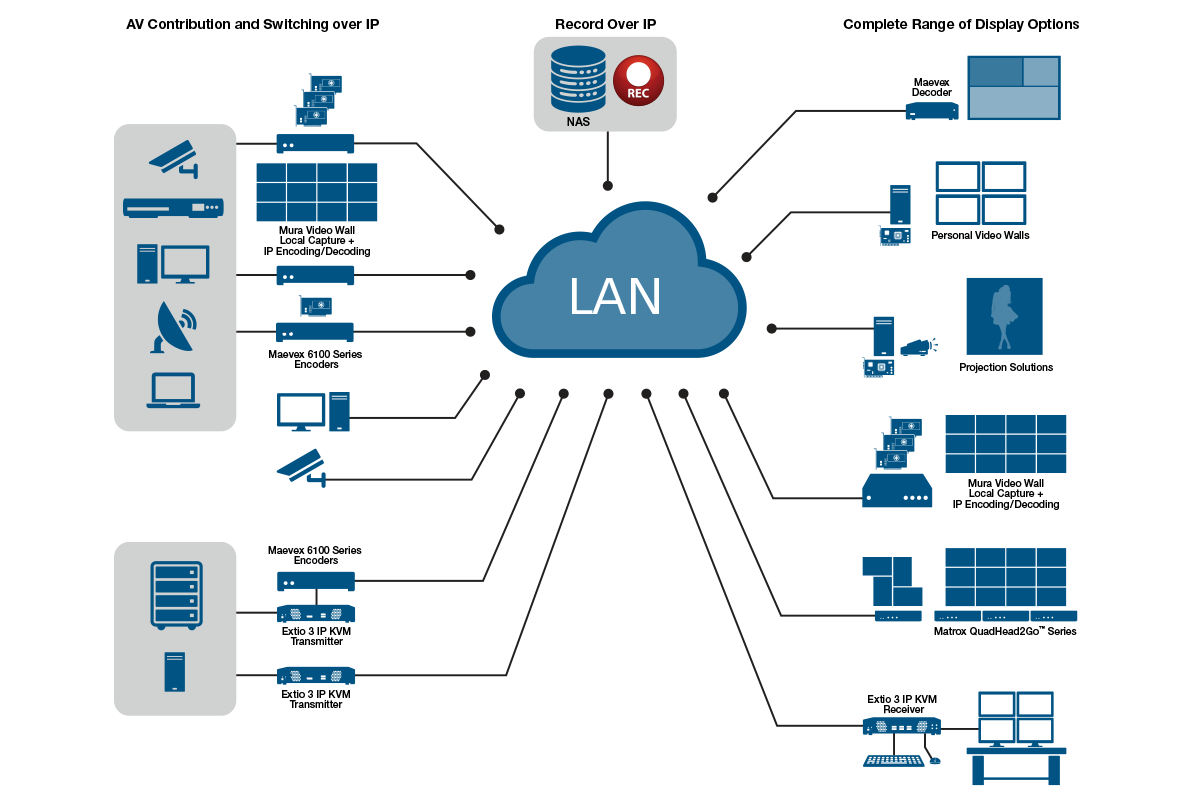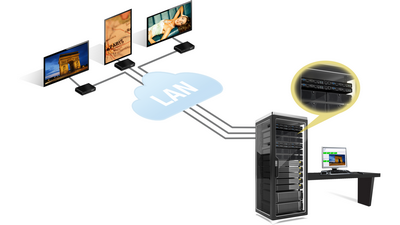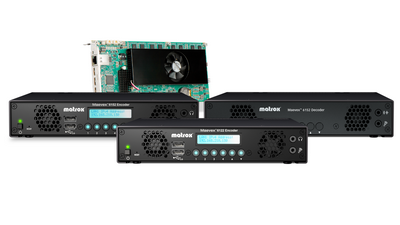Guides & Articles
AV Integrators, Don’t Fear the IT Network
Demand for AV over IP solutions means AV integrators must learn something new. The good news is it’s not as daunting as most think.
It is an indisputable fact that the AV industry is heading down the path where more signals are transported across IP networks. Achieving reliable, high-quality video and audio distribution over the network is now possible with less bandwidth than ever before. It is also well- documented that there are added benefits to transporting those signals through the network.
Why Converge?
In the traditional way of doing things, if we wanted to transmit a single audio or video signal, a specific cable type would be required to be present for the variety of devices and signal types in the system. Twisted pair for speakers, twisted pair with shield for mic or line level signals, 5-wire for RGBHV signals, coaxial cable, and HDMI all would need to find an independent pathway from the signal point of origin to the display.
The cost of these cable types varies greatly and can be very expensive, particularly if you are forced to purchase by the thousand foot roll. Then there is the labor to pull and terminate all that cabling and wide variety of connectors. The complexity level rises exponentially when different sources are expected to be routed to different destinations dynamically. All this shows that the infrastructure for AV systems can end up being expansive and expensive.
As the industry moves to transporting more audio and video signals over IP, each device can now be treated as an end point on the network, with standard category cables (e.g. Cat 5, Cat 6) and standard network equipment (e.g. switches and routers) in between.

Although different types of audiovisual products sometimes come with different connectivity (like composite video, s-video, component video, SDI, VGA, DVI, DisplayPort, HDMI, stereo audio mini-jacks, etc.), it is possible to convert most—if not all—current baseband signaling into IP streams that work over standard Category (Cat 5, Cat 6, etc.) cables, switches, routers, etc.
What that means is that device outputs can be converted and shared to one or many destinations over greater distances than what can be achieved in their native format. This includes being available wirelessly—at least to some extent.
To process baseband signals for distribution over the network, you’ll need an IP encoder at the source/input and a hardware or software decoder at the display/output. Once the signal is on the network it can be sent anywhere the network allows after that, greatly simplifying cabling. That simplicity is a major benefit for integrators; one that AV over IP can play a role in providing.
Comparing AV over IP to Classic AV Distribution
In their most basic forms, AV over IP solutions are similar to classic AV distribution systems. In the traditional system, each input, such as VGA, HDMI, or audio, would require an independent connection to either a media switcher, audio processor, or some other form of centralized system where it would then be transmitted to the end point devices like displays or speakers.
For AV over IP solutions, though, it is possible to remove the media switcher from the equation and have the input locations transmit directly to the network itself where the signal can then be routed to a networked AV receiver which is then connected to a local display or audio end point. With this AV over IP solution we aren’t limited to one type of signal across an independent cable connection.
In fact, the possibilities are greatly expanded because we can be passing audio, video, and even control over this single pipeline. The key to remember is that the network is just a pipe to transmit the signal so multiple video or audio streams could be sent simultaneously across the network and it would be the purpose of the receivers to determine which streams they wanted to access.
By not requiring a central media matrix, AV over IP allows integrators to populate end points anywhere in an already installed network system and route them accordingly. This means that in a retrofit situation there is no need to install new end points and pull cabling back to a central location. All that’s required is available network ports.
Isolated Networks & Hybrid Distribution Systems
In addition to the decreased costs of system infrastructure, AV over IP solutions also offer added flexibility. Networked AV systems can evolve and grow over time with the needs of the client. An AV integrator has the opportunity to start with a small, isolated system, potentially as small as one transmitter to one receiver, and gain an understanding of how these devices communicate and need to be configured for optimum operation.
Think of it like an introductory system for both the client and the integrator new to AV over IP. If the client is happy with their existing traditional AV distribution system but would like to expand its capabilities, an AV over IP solution doesn’t necessarily require a complete overhaul of the existing system. Existing AV infrastructure can continue to be leveraged, while growing the AV over IP component, so earlier investments are not lost.
In this hybrid type of a system it is possible to insert encoders in between current AV sources and their contemporary extension and switching equipment. By doing this the source will now be available beyond its local connections and can be viewed anywhere a network receiver might be. Once the sources are captured into Encoders they can be copied and split into a pass-through of the current signal type (without losing any quality) plus a new stream would now be available on the network.
Since the streams are on the network, the IP advantages of distance and new devices (wireless tablets for example) are available. So AV over IP can, if required, be deployed: incrementally (as needed); (optionally) in conjunction to existing infrastructure; and as budgets permit.
What to Look for in an AV over IP Solution
Selecting the right AV over IP solution involves a bit of research. Integrators should invest some time to be sure the product features suit the needs of the client.
With so many different options available to integrators, the first thing to be certain of is that the solution you are selecting is going to address network bandwidth requirements while providing the video and audio quality the customer is looking for and also making sure the integration is easy, flexible and cost effective for clients.
Tip #1: Bandwidth is king.
If you want to take advantage of an existing network, you will likely be working with network administrators who are responsible for all network traffic including Internet access, e-mail, and even VoIP phones. They will have real bandwidth concerns, and will be looking for specific information from the integrator as to what the AV over IP devices will be doing on their network.
They may limit the amount of bandwidth available for AV distribution, and finding out what the bandwidth requirements are in advance can help you specify the right AV over IP devices. Look for products that are low bandwidth by default, with adjustable bit rates to help you – or the network administrator – fine-tune streaming parameters and stay under the required bandwidth.

Tip #2: Not all products are equal when it comes to resolution support.
If your clients want to stream high-definition video, look for products that support Full HD 1080p60 and 1920x1200 video distribution. Higher resolution can mean higher bandwidth, but the type of compression used can help, so be sure to check what codec is being used. Encoders and decoders utilizing the H.264/MPEG-4 AVC codec are highly prized for high-quality, low-bandwidth projects.
Tip #3: Non-proprietary encoding.
Some AV over IP devices are purpose-built with proprietary streams that only the vendors’ equipment can decode and these products may have a legitimate value add in specific circumstances.
However, if the product requires proprietary decode, there are many things you may not be able to do cost effectively, including viewing network streams using free software decode on your desktop. If you want to future-proof your investment, look for open, standards-based encoding solutions that won’t tie you to a specific product or vendor.
Tip #4: Control is key.
AV over IP devices should come with software that allows you to auto-detect & monitor devices remotely and easily switch streams at different endpoints and adjust encoding and decoding parameters when necessary. If you want to offer your client a custom control app, look for products that provide software development tools.
A good API will allow developers to create a software interface that is customized for their client and even integrate device control within a larger control app.
One example of an AV over IP encode/ decode solution is our Matrox Maevex. Video and audio quality is exceptional, with the ability to distribute up to Full HD 1080p at 60 Hz or 1920 x 1200 with open encoding using the H.264 codec.
As mentioned, one of the biggest concerns regarding AV over IP is going to be bandwidth and Maevex provides excellent quality results with a meager default bit rate of only 15 Mbps. Our product also provides flexibility with the ability to adjust bit rates between 100 Kbps and 25 Mbps, along with many other encode and decode parameters. With the power to balance bandwidth and quality, you can fine tune AV streams according to the needs of your given application and the bandwidth available on the network.
Combined with the intuitive PowerStream management and control software and API, and the added feature of being able to record content to network-attached storage anywhere on the LAN, Maevex is a great product for those looking to dip their toe into the AV over IP world, and grow from there. It is ultimately very scalable, both robust and flexible enough to continue building on over time, as you and your clients gain experience.
AV solutions utilizing the network are proving to be the next evolution of AV technology. If integrators are to continue to be successful, they will be required to gain some knowledge and experience with network IP system solutions, but you don’t have to become an IT specialist overnight.

The right choice of product can help AV professionals enter the market regardless of their level of network expertise. AV solutions utilizing the network are proving to be the next evolution of AV technology. Ignoring the steps the market is taking to incorporate the benefits of IP-based AV is perilous. But from teams that possess certified network professionals who are swimming in experience in this area, all the way down to the smaller installation dealers that pride themselves on providing customer value additions in areas as foreign to IP as acoustics, ergonomic room design, basic cable wiring, and AV product installation, the range of products now being offered afford the professional AV channel the ability to enter the market with products and services regardless of their experience level.
As the client grows, and the integrator gains familiarity with IP systems, so too can the networked AV solution and its capabilities.



